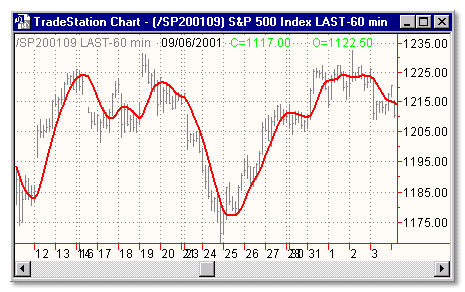Download: smooth.ela
File Includes:
Indicator - T3
Function - GD
Indicator - IE/2
Category: Averages > T3
Description:
This indicator plots the moving average described in the January, 1998 issue of S&C, p.57, "Smoothing Techniques for More Accurate Signals", by Tim Tillson. This indicator plots T3 moving average presented in Figure 4 in the article. T3 indicator is a moving average which is calculated according to formula:
where GD - generalized DEMA (Double EMA) and calculating according to this:
where "v" is volume factor, which determines how hot the moving average’s response to linear trends will be. The author advises to use v=0.7.
When v = 0, GD = EMA, and when v = 1, GD = DEMA. In between, GD is a less aggressive version of DEMA. By using a value for v less than1, trader cure the multiple DEMA overshoot problem but at the cost of accepting some additional phase delay.
In filter theory terminology, T3 is a six-pole nonlinear Kalman filter. Kalman filters are ones that use the error — in this case, (time series - EMA(n)) — to correct themselves. In the realm of technical analysis, these are called adaptive moving averages; they track the time series more aggres-sively when it is making large moves. Tim Tillson is a software project manager at Hewlett-Packard, with degrees in mathematics and computer science. He has privately traded options and equities for 15 years.
Usage:
The most popular method of interpreting a moving average is to compare the relationship between a moving average of the security's price with the security's price itself (or between several moving averages).

Inputs:
Price - price type to use
Period - number of bars to use in calculation
VFactor - volume factor, which determines how hot the moving average’s response to linear trends will be
EasyLanguage Code:
INPUTS: PRICE(CLOSE), PERIOD(6), VFACTOR(.7);
VARS: T3(0);
T3 = GD (GD (GD (PRICE, PERIOD, VFACTOR), PERIOD, VFACTOR), PERIOD, VFACTOR);
PLOT1(T3, "T3");
IF CLOSE CROSSES ABOVE PLOT1 OR CLOSE CROSSES BELOW PLOT1 THEN
ALERT = TRUE;
{COPYRIGHT C 1997, TECHNICAL ANALYSIS, INC.}